A client experiences an ABO incompatibility reaction after multiple blood transfusions. Which finding should the nurse report immediately to the healthcare provider?
Lower back pain and hypotension.
Delayed painful rash with urticaria.
Acute rhinitis and nasal stuffiness.
Arthritic joint changes and chronic pain.
The Correct Answer is A
Lower back pain and hypotension are symptoms of an ABO incompatibility reaction, which is a serious complication of blood transfusion. This reaction occurs when the client receives a blood type that is incompatible with their own. It can cause a rapid and severe response, including back pain, hypotension, fever, and chills. This should be reported immediately to the healthcare provider.
Nursing Test Bank
Naxlex Comprehensive Predictor Exams
Related Questions
Correct Answer is B
Explanation
Choice A rationale
Decreasing the flow rate of the irrigation solution is not the best action in this situation. The presence of blood clots in the tubing and collection bag indicates that the client may be experiencing clot retention, which can lead to urinary obstruction. Decreasing the flow rate may not provide sufficient force to dislodge clots from the catheter, which could exacerbate the problem.
Choice B rationale
Manually irrigating the catheter is the most appropriate action when blood clots are observed in the tubing and collection bag. Clots can obstruct the catheter and disrupt the continuous bladder irrigation, leading to urinary retention and increased discomfort for the client. Manual irrigation can help dislodge and remove these clots, ensuring the patency of the catheter and the effectiveness of the irrigation.
Choice C rationale
Discontinuing the infusion of the irrigation solution is not the best action in this situation. The purpose of continuous bladder irrigation after a transurethral resection of the prostate is to prevent clot formation and retention by continuously flushing the bladder. Discontinuing the infusion could lead to the formation of more clots, potentially causing urinary obstruction.
Choice D rationale
While monitoring catheter drainage is an important part of postoperative care, it is not the most appropriate action in this situation. The presence of blood clots in the tubing and collection bag indicates a potential problem that requires immediate intervention. Simply monitoring the situation without taking action to resolve it could lead to urinary obstruction and increased discomfort for the client.
Correct Answer is A
Explanation
Choice A rationale
A lumbar puncture is a key diagnostic procedure for suspected bacterial meningitis. It allows for the collection of cerebrospinal fluid, which can be analyzed for signs of bacterial infection.
Choice B rationale
Skull radiography is not typically used to diagnose bacterial meningitis. While it can help identify abnormalities in the structure of the skull or brain, it cannot detect the presence of bacteria.
Choice C rationale
While an MRI can provide detailed images of the brain and surrounding tissues, it is not the primary tool for diagnosing bacterial meningitis. It may be used in conjunction with other tests, but a lumbar puncture is more definitive.
Choice D rationale
A CT scan can be used to detect abnormalities in the brain, such as swelling or inflammation, which could be indicative of meningitis. However, it cannot definitively diagnose bacterial meningitis.

Whether you are a student looking to ace your exams or a practicing nurse seeking to enhance your expertise , our nursing education contents will empower you with the confidence and competence to make a difference in the lives of patients and become a respected leader in the healthcare field.
Visit Naxlex, invest in your future and unlock endless possibilities with our unparalleled nursing education contents today
Report Wrong Answer on the Current Question
Do you disagree with the answer? If yes, what is your expected answer? Explain.
Kindly be descriptive with the issue you are facing.
